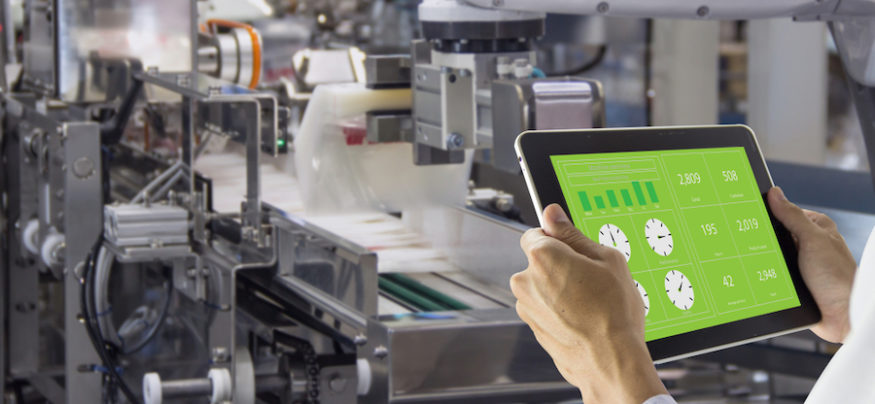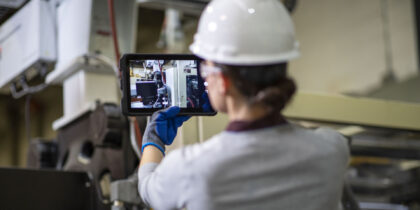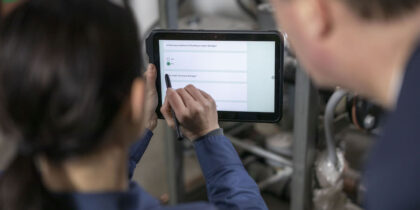Big data is widely heralded as a core driver of efficiency and productivity, and manufacturers are eager to reap the benefits. Organizations need to do a lot of things well to realize the value of big data: digitize their data, move it out of silos into data lakes and develop analytics applications that derive essential insights.
For all the talk we hear about big data, you might think smart factories are the norm, but the truth is that many manufacturers are still in the early stages of going digital. A 2018 Forrester survey found that over half of the companies surveyed had embarked on a digital transformation, but only 19 percent had seen the process through.
Integrating mobile devices is essential to success. On the front end, versatile devices such as the Samsung Galaxy Tab Active2 harvest data on the production floor, then deliver analysis-based insights to production workers to support better decision-making on the back end.
From Mainframe to Mobile
Traditional manufacturing companies have typically relied on onsite mainframe servers, but many are in the process of migrating to cloud computing. Hybrid computing, which is a mix of mainframe and cloud computing, has proven to be an effective transitional solution. It efficiently handles the scale of computing by routing non-time-critical tasks to the cloud, and the rest to an edge computer close to the data source. Hybrid computing also scales up and down on demand, which means smart factories that process data this way are more agile, easily adapting to changes in their data processing needs.
Industry 4.0 is accelerating the adoption of edge computing. IDC predicts that by 2022, edge computing will make up over 40 percent of cloud deployments, and a quarter of those will be executing AI algorithms.
Improving Data Collection
When business leaders embrace big data initiatives, their attention naturally goes to technology like analytics engines and cloud-based data lakes. You need to step back and see the big picture, because “garbage in, garbage out” is an apt expression for big data initiatives.
Modernize Your Factory With Mobile
Get your free guide to the mobile technologies that will accelerate your smart factory journey. Download Now
To run a smart factory, you need to excel at gathering information digitally to feed your analytics engine. That means digitizing every data collection process and replacing every single clipboard and No. 2 pencil with a mobile device that sends information to a database in real time. As long as your employees are transcribing data from paper to digital, data movement is slowed and accuracy is diminished.
Devices like the Tab Active2 eliminate those obstacles. Production workers can begin recording every machine reading and task completion on the tablet, which accelerates your data while reducing errors. At the same time, you are optimizing labor by eliminating repetitive tasks.
Edge Processing for Production Insights
Once your big data analysis is yielding insights, mobile devices play a critical role in delivering that intelligence of the production arena. With its powerful edge computing capabilities, the Tab Active2 is an essential conduit that transforms intelligence to action by empowering the production employee to make faster, smarter decisions on machine maintenance.
To achieve ROI on big data, manufacturers need to process information in split-second intervals and act intelligently on the resulting insights. Mobile devices facilitate such processes at the edge by scanning and processing data to interact with analytics-based insight. A device like the Tab Active2 can analyze data from embedded devices and contrast it against proprietary machine learning algorithms to spot anomalies that could indicate trouble. When an employee is able to identify maintenance issues in a timely manner, you can implement predictive maintenance and increase production uptime, making your big data initiative pay off.
Tablets dedicated to specific machines can take the temperature (both literally and figuratively) of these pieces of equipment and help prevent machine failures that constrict production. A digitized manufacturing execution system can also improve utilization by automatically rerouting production to underutilized lines.
Harnessing Data Through Mobility
As a general rule, the farther along the factory is on the path to becoming a smart factory, the more it is able to leverage the principles of Industry 4.0. Manufacturing companies must therefore embrace the potential of mobile devices as soon as possible, moving the needle closer to complete digital transformation and allowing them to benefit from the full range of capabilities that mobility delivers.
Get a boost on your smart factory journey with our free, comprehensive guide on mobile transformation in manufacturing.








